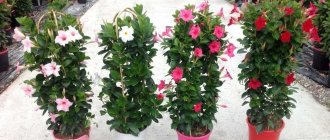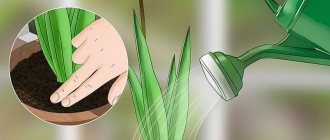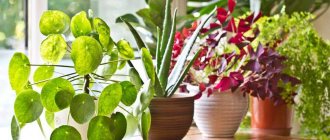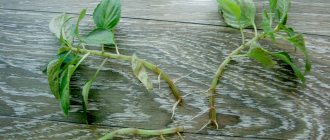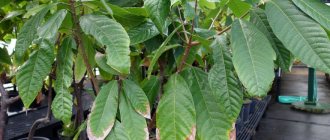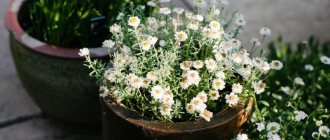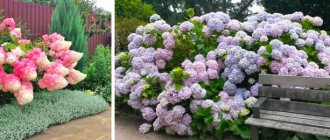Photo Oleander (Nerium oleander) - an evergreen shrub from the Kutrovye family. The plant appeared in the subtropics of the Mediterranean. Its close relatives are herbaceous plants, parasitic vines and giant tropical trees. In the wild it is found in the form of tall (up to 4 m) powerful bushes in the river valleys of Asia Minor, in the Caucasus Mountains, and grows in Algeria and Italy. There is only one cultivated form of this plant, and it is called “common” oleander! They are grown in open ground and used in landscape design on the Black Sea coast and in the Crimea.
In areas located to the north, the plant is grown in greenhouses and at home. Oleander grows quickly, growing 30 cm per year. At home it can grow more than 2 meters if the growth is not limited by pruning. It usually lives in an apartment for up to 15 years, but if the bush is rejuvenated and properly cared for, it can live longer. Flowering continues from July to October. On the shoots, large bright flowers are adjacent to unopened buds, so it seems that it is blooming constantly.
| Grows quickly, up to 30 cm per year. |
| Blooms from mid-summer to mid-autumn. |
| The plant is easy to grow. |
| Perennial. |
Description
The homeland of oleander is the Mediterranean countries. It can also be found in Crimea and Transcaucasia.
The stems of the bush are covered with light gray or light brown bark.
The leaves are lanceolate, grow in whorls of 3, but can also be opposite. They are dark green on top and lighter at the bottom. Rare varieties are variegated.
The surface of the leaf plate and the edges are smooth, without roughness or notches. There is a pronounced vein running down the middle.
Flowering time is all summer and part of autumn. Buds appear only on young shoots.
The flowers are small, 3-5 cm in diameter. They are collected in inflorescences resembling a semi-umbrella and can be simple or double.
The oleander plant is poisonous: all its parts contain cardiac glycosides (oleandrin, cornerin, etc.).
Juice poisoning causes colic, vomiting and diarrhea. The substances included in its composition disrupt the functioning of the nervous system and cause cardiac arrest.
The aroma of the plant is quite pleasant, but can cause dizziness.
The oleander flower also has popular names:
- pink laurel;
- bad guy;
- down jacket;
- scarecrow;
- Leander
Indoor oleander: what to do after purchase?
If the pot is too small for the plant, the oleander should be replanted. The new pot should be slightly larger than the previous one, with good drainage holes. A layer of expanded clay or broken brick should be placed at the bottom, then a little soil mixture of turf, leaf soil, peat, humus, coarse sand should be poured in a ratio of 2:1:1:1:1 . After transplantation, the plant should not be immediately placed in bright light. It is better to accustom him gradually.
Varieties with photos and names
Oleander is a monotypic genus. It contains only one species of the plant, Nerium oleander. All varieties of oleander grown at home originate from it thanks to the work of breeders.
White
There are two popular white oleander varieties: Casablanca and Mont Blanc. Both are considered quite unpretentious. But the second blooms much more abundantly and longer.
Casablanca on the left and Mont Blanc on the right
Other white varieties:
- Alba;
- Sister Agnes;
- Madonna Grandiflora
- Hardy white.
Pink
Pink oleander is the most common.
Variegated oleander on the left and the variety Emily Salute on the right
Varieties with this petal color include:
- Variegata - distinguished by variegated leaves;
- Rigoletto - has flowers with curled petals;
- Triumph - variety with pink-purple flowers;
- General Pershing - there is a white pattern on the pink petals;
- Furet - the petals have a pale pink color;
- Double Peach - double buds with light coral petals;
- Emilie Salut - gives the most abundant flowering of those listed;
- Martha Hanna Henslee - pink buds with dark veins;
- Roseum Plenum - characterized by large (up to 7 cm) flowers.
Most pink oleanders are characterized by double flowers. Simple flowers are produced by varieties such as Belle Helene and Hardy Pink.
Yellow and peach
Well-known varieties of yellow oleander are Maria Gambetta, Mathilde Ferrier and Luteum Plenum.
Sherrie Allen Turner, Angiolo Pucci and Mrs Roeding, Apricot Queen are painted in peach tones.
Reds
Red and burgundy oleanders are no less popular than pink ones.
The following varieties are known:
- Cardinal - deep burgundy, regular petals;
- Cerisa is an oleander with double flowers of bright crimson color;
- Hardy red - scarlet buds;
- Rubis - bright red double flowers;
- Algeria is a dark red oleander.
Other varieties of common oleander
Plants such as Fragrant Oleander and Indian Oleander are found in nature. They are also considered a subspecies of Nerium oleander. They are not cultivated at home.
A distinctive feature of Indian Oleander is its turquoise flowers. They can also be white, pink and red. Oleander Fragrant is a compact bush with double inflorescences.
Varieties for home cultivation
The oleander bush has dense bright green glossy leaves of an elongated shape, double or smooth flowers of red, pink, white or yellow.
Varieties for home cultivation differ in color and shape of inflorescences:
- Soleil Levant – up to 40 pink flowers per branch;
- Petit salmon – pastel inflorescences with a bright yellow center;
- Variegata - long, needle-shaped inflorescences hanging to the ground;
- Hardy red – bright scarlet flowers;
- Cardinal – rich burgundy color.
Oleander bushes reach impressive sizes. In natural conditions, for example, the Indian oleander reaches a height of four meters. At home, the bush is pruned, shaping the size of the plant to suit the decorative needs of the room. But even in apartment conditions, the bush can grow up to two meters in height.
Oleander: care at home
Caring for oleander at home is considered simple. The flower easily tolerates the summer heat and is not afraid of the bright sun.
But you will have to pay attention to the bush almost every day - in the summer it needs frequent watering.
Pot location and lighting
Oleander is a light-loving plant. The best place for it is the window sill of a south window. The leaves easily tolerate direct sunlight.
If the flower has already grown enough, it can be placed on the floor, but not far from the window. In winter, the pot should not be located close to the radiator.
On the northern, and often even on the western and eastern sides, the flower will lack light.
A sign of lack of light is faded leaves and small flowers.
If the problem is not eliminated, the shoots of the bush will stretch out and it will stop producing buds.
If it is not possible to provide the oleander with natural light, it needs to be supplemented with additional lighting. The lamps are not placed too close to the pot. The minimum distance is 70 cm.
It is better to place a pot of pink laurel in a spacious living room that can be frequently ventilated.
In a small bedroom, the aroma of a flowering bush can cause discomfort to the owner.
In summer, the pot can be placed on the balcony or terrace of the cottage.
If there are children or animals in the house, it is better to avoid growing oleander or place it in a place completely inaccessible to them.
You can be poisoned even by a small piece of oleander leaf.
Temperature
Temperature indicators that the owner of the oleander must take into account are given in the table.
| Period | Optimal temperature, °C | Limit temperature, °C |
| Summer | 24-28 | 32 |
| Winter | 12-15 | 5 |
Oleander can only withstand short-term frosts. Constant exposure to sub-zero temperatures will destroy the flower.
With the onset of the dormant period, you need to gradually prepare the plant for a cool winter. To do this, the temperature is reduced daily by 1-2°C.
If you immediately move the pot from the room to a cold room, the bush will freeze.
In the same way, they gradually increase the temperature in the spring and accustom the plant to the bright light of the sun.
Popular questions and answers
We talked about growing oleander at home with agronomist-breeder Svetlana Mikhailova.
Is it true that oleander is poisonous?
True, its toxicity is high. If the juice of this plant gets into the gastrointestinal tract, you are guaranteed diarrhea and vomiting, and in large doses it can cause cardiac arrest. It is for this reason that oleander is not recommended to be grown in an apartment if there are small children and animals at home - it is also deadly for cats and dogs.
After working with oleander, you should wash your hands thoroughly with soap.
How to choose an oleander?
It is important that the plant looks healthy, with clean, shiny leaves. Check it carefully for the presence of pests - they love to settle on the oleander.
What kind of pot is needed for oleander?
Oleander grows very quickly, so you need to choose a spacious pot for it. And preferably ceramic - plastic ones can tip over when the bush grows a large mass.
Why doesn't the oleander bloom?
The most common reason is lack of lighting. Oleander is very light-loving! The second reason is that the bush was not pruned. If it grows “with a stick”, in one trunk, you are unlikely to see flowers. This is where pruning will help.
Well, of course, it will not bloom if it is sick or affected by pests.
Why do oleander leaves fall?
The most obvious reason is lack of moisture. Oleander is very sensitive to drought. If you don’t water it on time once, it immediately drops its leaves. And, of course, the leaves will fall off if the plant is sick.
Sources
- Korsakova S.P., Plugatar Yu.V., Ilnitsky O.A., Kleiman E.I. Features of water metabolism of Nerium oleander L. in conditions of progressive soil drought // South of Russia: ecology, development, vol. 13, No. 1, 2018 https://cyberleninka.ru/article/n/osobennosti-vodnogo-obmena-nerium-oleander -lv-usloviyah-progressiruyuschey-pochvennoy-zasuhi
- Spotar E.N. Biological features of growth and development of shoots of Nerium oleander L. in the conditions of the Southern Coast of Crimea // Plant biology and horticulture: theory, innovations, 2014 https://cyberleninka.ru/article/n/biologicheskie-osobennosti-rosta-i-razvitiya-pobegov -nerium-oleander-lv-usloviyah-yuzhnogo-berega-kryma
- State catalog of pesticides and agrochemicals approved for use on the territory of the Russian Federation as of July 6, 2022 // Ministry of Agriculture of the Russian Federation https://mcx.gov.ru/ministry/departments/departament-rastenievodstva-mekhanizatsii-khimizatsii- i-zashchity-rasteniy/industry-information/info-gosudarstvennaya-usluga-po-gosudarstvennoy-registratsii-pestitsidov-i-agrokhimikatov/
Transfer
A planned oleander transplant is carried out in mid-April. In the first 4 years of a flower’s life, its pot is changed annually.
For an older plant - once every 2-4 years, when the roots entwine the entire earthen ball. For an overgrown tree, it is enough to renew the top layer of soil mixture in the container.
Signs that a flower needs replanting:
- roots are visible from the drainage hole;
- the soil has become too dense and cannot be loosened;
- A white coating appeared on the soil surface.
Pot
For young seedlings, take containers with a diameter of 7-9 cm.
When replanting, the new oleander pot should be 2-3 cm larger than the previous one.
The plant produces buds only if the roots have mastered the earthen ball available to them. Therefore, having transplanted the bush into a container that is too large, you can allow it to bloom.
But if the pot is too tight and the root becomes deformed, this will lead to slower growth.
My oleander has already grown quite large. During replanting, I shorten the roots and return the tree to the same pot so that it does not grow even larger. Anna Sviridova, Ryazan, 10 years of experience in growing oleander.
Be sure to have drainage holes. And the pot for an adult specimen should be quite stable. Overgrown trees are planted in tubs.
The soil
The main requirement is that the soil for planting oleander must be loose and breathable.
Ready-made formulations designed specifically for oleander are not sold in flower shops.
You can use palm soil or any peat mixture that is suitable for acidity.
Recommended soil pH is 7-8.
A simpler option for preparing the soil yourself is turf soil, humus and peat, taken in equal proportions.
Sequencing
Step-by-step instructions for transplanting oleander:
- Water the plant generously so that the earthen lump is easily separated from the walls of the old pot.
- Place a layer of drainage (expanded clay, pebbles) on the bottom of the new container up to ¼ of the height of the pot, cover it with soil.
- Remove the bush from the old pot and inspect the roots.
- If damaged areas are found, cut them off and disinfect the “wounds” with crushed coal. If the roots are healthy, do not destroy the earthen ball.
- Place the flower in the center of the new pot, fill the free space with soil.
- Water the oleander and place it in a shaded place for several days.
You can see how oleander is transplanted in the video below.
Briefly about cultivation
- Flowering: from June to October.
- Lighting: bright sunlight.
- Temperature: in spring and summer - 20-28 ºC, in autumn the temperature is reduced to 18 ºC, and in winter the flower is kept cool - from 8 to 18 ºC.
- Watering: in spring and summer - after the top layer of soil has dried, and in extreme heat, excess water is left in the pan. In autumn and winter, the substrate is allowed to dry to a slightly greater depth.
- Air humidity: moderate, but in hot weather it is better to place nerium on a tray with wet expanded clay.
- Feeding: in the spring-summer period - 2-4 times a month with mineral fertilizer for flowering plants. The solution is poured into the substrate half an hour after watering.
- Dormant period: from November to the end of February.
- Pruning: after flowering is complete.
- Transplantation: at the end of spring: young oleanders - annually, adults - once every 2-3 years. For very large plants, the top layer of substrate in the pot is replaced every spring.
- Substrate: one part each of sand, leaf soil, peat, humus and two parts of turf soil.
- Reproduction: seeds and cuttings.
- Pests: mealybugs, scale insects, spider mites and aphids.
- Diseases: the plant may lose its decorative qualities due to improper maintenance and poor care.
- Properties: Nerium is poisonous, but medicines for heart disease are produced from its leaves.
Read more about growing oleander below.
Oleander propagation
The method of propagation of oleander depends on the time of year. When choosing, you also need to consider how quickly you want to get flowering.
Air layering
This method is used in the summer, when the oleander does not need pruning. Only young shoots are taken as layering.
Step-by-step instructions on how to propagate oleander by layering:
- On the selected branch, cut off the bark in a circular manner. The distance from the cut to the end of the shoot is 10-15 cm. The thickness of the “ring” is 2-3 cm.
- Wrap the cut area with moss or place it in a bag of sand.
- Moisten moss or sand regularly.
- When sufficiently strong roots have formed, cut off the top.
- Plant a new specimen in a pot.
- Sprinkle the cutting area on the mother plant with charcoal.
The first roots will appear in about a month, and the seedling can be separated after 2-3 months from the start of the procedure.
The advantage of this method is the fastest appearance of buds in a young oleander.
By cuttings
To obtain a new oleander, shoots removed during pruning are used or a shoot is selected whose disappearance will not spoil the appearance of the bush.
As a cutting, take a young branch about 15 cm long. It should have a growing point and several leaves.
Step-by-step instructions for rooting an oleander cutting in a substrate:
- Treat the cut - dip in water and Kornevin powder.
- Place in a damp mixture of peat and sand. Deepen approximately 1 cm.
- Cover the container with film. Keep the improvised greenhouse in a bright place at a temperature of 20-22°C and ventilate regularly.
- After 1-1.5 months, plant the established specimens in the soil for an adult plant.
Oleander cuttings are also rooted in water. They are placed in warm, settled water no deeper than 1.5 cm. The leaves do not need to be torn off.
Liquid is added as needed. You can add activated carbon and root.
The cuttings are planted in the pot when the roots grow to 3-5 cm.
The first pruning of a young specimen is carried out after about six months.
You can see how oleander is cut by watching the video.
Seeds
Propagating oleander by seeds is not the most popular method. The reason for this is their low germination rate. In addition, it will take several years to wait for flowering with this method.
Step-by-step instructions for growing oleander from seeds at home:
- Treat the seeds with Epin or another growth stimulant.
- Place a wet mixture of sand and soil on the bottom of the container.
- Spread the seeds on the surface of the substrate. Don't bury it.
- Cover the container with film or a transparent lid.
- Keep in a bright place at a temperature of 30-35°C, regularly ventilate and moisten.
- When shoots appear, remove the film. Transfer the container to a cooler place (20°C).
- Plant young oleander specimens when they have 3-4 leaves.
Dividing the bush
The method is only suitable for large bushes with a well-developed root system.
The procedure is performed at the time of transplantation. The roots are cleared of soil and the bush is cut into pieces with a clean knife or pruning shears.
The cut areas are sprinkled with charcoal and dried. Each specimen is planted in a separate, smaller pot than before.
Rooting in water
This method of propagating oleander should be used if the temperature in the room where you will root the cuttings does not rise above +30 degrees. In this case, place the workpieces in containers with water with the addition of a root formation stimulator. Make sure that the temperature of the solution fluctuates between +20...+27 degrees. And also add water to the container as it evaporates.
Keep the cuttings in an area with bright but indirect light, away from direct sunlight. Rooting the cuttings in water will take about 35-40 days, during which time they should grow roots 3 cm long. As soon as this happens, plant the seedlings in individual pots.
Frequent care errors and their consequences
The loss of decorativeness by a flower is a direct consequence of mistakes made in caring for the oleander.
Botanist's opinion
An exception may be the fall of leaves - once every 3-4 years, adult oleanders renew their crown.
The table shows the most common problems and their probable causes.
| Flower problem | Provoking factor |
| The leaves are turning yellow | Overwatering the plant Unsuitable fertilizers |
| The tips of the leaves dry out | Insufficient watering Low humidity |
| The lower leaves are falling | Lack of light |
| The bush sheds leaves all over its height | Hypothermia Draft |
| The flower sheds its buds | Hypothermia Watering with cold water |
| Leaves and shoots have become lethargic | Root rotting due to overwatering |
Violation of the rules for caring for oleander can lead to the development of infections.
Plant care
Indoor oleander is a relatively unpretentious plant; caring for it mainly consists of conventional agrotechnical measures:
- regular and abundant watering;
- periodic feeding;
- pruning;
- planned transplant.
In addition, in order for the oleander to grow as a lush and attractive bush, it is important to create comfortable conditions for the flower. And to do this, you need to maintain a certain humidity, temperature and light in the room with the plant.
Diseases and pests
Powdery mildew most often affects oleander. The leaves of the bush are covered with a whitish coating.
These white spots are easily erased, but quickly reappear. If the flower is not treated, they acquire a brown tint.
Fungicides, such as Strobi or Quadris, are suitable for control.
Oleander also suffers from other diseases:
- botrytis appears as a gray powdery coating on the foliage;
- cercospora blight causes dark specks on the petioles and leaves of the plant;
- anthracosis causes spots on the foliage; at the beginning of the disease they are light with dark edges, then they darken and merge;
- aspergillosis leads to the appearance of a black coating, and over time, to the death of leaves;
- In the first days, rust appears as yellow spots; over time, they acquire a characteristic brown tint.
In addition to common diseases of indoor plants, pink laurel is characterized by infection with Pseudomonas savastanoi pv. nerii.
A sign of infection of an indoor flower with oleander cancer is dark growths on all parts of the plant.
Affected shoots must be removed immediately before the disease spreads. There is no cure for it. Prevention - pruning the flower only with a clean tool.
Oleander pests are listed in the table.
| Insect | Signs of infection |
| Spider mite | Whitish dots appear on the leaves, and as they develop, spider webs |
| Mealybug | Plaque that looks like pieces of cotton wool |
| Shields | Dark bumps and sticky coating on leaves |
| Aphid | Insects are visible to the naked eye Leaves curl and become deformed |
When damaged by pests, the flower is bathed in the shower with laundry soap. In the case of scale insects, it is more effective to collect it with a cotton pad soaked in alcohol.
After mechanical removal of insects, the bush is sprayed with insecticides. Actellik is suitable in almost any case.
From the video below you can learn about traditional methods of pest control.
FAQ
What to do if the oleander does not bloom
The most common reason for the lack of buds is failure to trim. A lack of light can also lead to this situation. A sick, frozen plant will not bloom. If there are no buds, the gardener needs to analyze how he cares for the oleander, find and correct his mistake. In this case, it is impossible to give an unambiguous recommendation. “Stress” to stimulate flowering is not suitable for oleanders.
Why do oleander leaves turn faded?
This situation indicates a lack of light. Leaves lose color due to disruption of the photosynthesis process.
What to do if the oleander drops its leaves
If the bush begins to lose leaves, it needs to be moved to a warmer room. When ventilating the room, take the flower out of it. You also need to make sure that the plant is watered deeply enough and has enough light. If these factors are the problem, the leaves usually dry out first and then fall off.
What to do when the oleander has faded
When flowering ends, you need to remove the faded buds, carry out formative pruning and begin to prepare the bush for a cool winter, gradually lowering its temperature.
What are the beneficial properties of the flower?
Glycosides contained in the plant are used in pharmacology. Tinctures and lotions from the leaves of the plant are also used in folk medicine. Oleander leaves secrete phytoncides that cleanse the air of bacteria.
How to choose an oleander
First of all, pay attention to the condition of the leaves. They should be clean and shiny. If they have black dots on them, you should refuse to purchase. The condition of the soil is also important; there should be no signs of waterlogging.
How to care for planting
In order for the seeds to germinate, it is important to maintain the temperature in the greenhouse within +25 °C. You should not allow it to rise to +35 °C, otherwise the plants will “burn.” And you also need to make sure that the temperature in the greenhouse does not drop below +22 °C, as this will lead to rotting of the seeds.
Otherwise, caring for crops consists of daily ventilation of the greenhouse, as well as periodic moistening of the soil. It is also important to provide the plants with enough light. Therefore, if the weather is cloudy outside, it is advisable to arrange additional illumination with a phytolamp.
Under such conditions, seeds will germinate in 30 to 90 days. When the seedlings emerge, begin to gradually accustom them to normal conditions. To do this, remove the cover first for 30 minutes, then for an hour, and so on. When the seedlings have two pairs of true leaves, plant them in individual pots.

